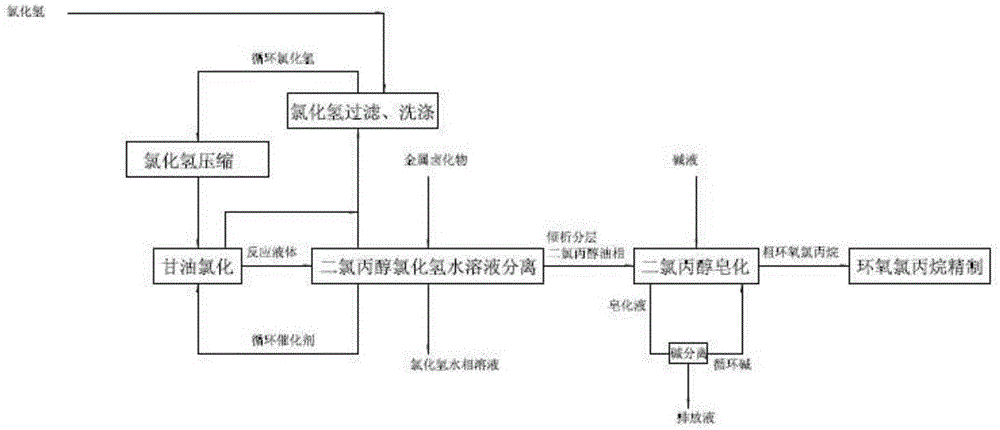A kind of method of producing epichlorohydrin
A technology of epichlorohydrin and crude epichlorohydrin, which is applied in the field of production of epichlorohydrin by the glycerol method, and can solve problems such as leakage, increased cost, and increased equipment investment
- Summary
- Abstract
- Description
- Claims
- Application Information
AI Technical Summary
Problems solved by technology
Method used
Image
Examples
Embodiment 1
[0034] The present invention will be described in detail below in conjunction with the drawings and specific embodiments, but the drawings and specific embodiments do not constitute a limitation to the present invention. The process includes the steps of glycerin chlorination, dichloropropanol hydrogen chloride aqueous solution separation, hydrogen chloride compression, dichloropropanol saponification, epichlorohydrin refining and other steps.
[0035] (1) Glycerin chlorination liquid 95% by weight of refined glycerin is sent from the tank area to the chlorination reactor. At the same time, the catalyst storage tank is mixed with a certain amount of glycerin according to the metering and then sent to the swirl plate reactor for glycerin chlorination. The flow of hydrogen chloride is passed The flow rate of glycerin and glycerin is controlled by flow meter and regulating valve respectively to ensure the flow ratio and distribution of the reactor into the reactor. The gas raw ma...
Embodiment 2
[0051] The present invention will be described in detail below in conjunction with the drawings and specific embodiments, but the drawings and specific embodiments do not constitute a limitation to the present invention. The process includes the steps of glycerin chlorination, dichloropropanol hydrogen chloride aqueous solution separation, hydrogen chloride compression, dichloropropanol saponification, epichlorohydrin refining and other steps.
[0052] (1) Glycerin Chlorination
[0053] The liquid 95% by weight refined glycerol is sent from the tank area to the chlorination reactor, and at the same time, the catalyst storage tank is mixed with a certain amount of glycerin according to the metering and then sent to the bubble column reactor for glycerin chlorination. The flow of hydrogen chloride is matched with the flow of glycerin. The ratio is controlled by the flow meter and the regulating valve respectively to ensure that the flow ratio and distribution into the reactor ar...
PUM
| Property | Measurement | Unit |
|---|---|---|
| boiling point | aaaaa | aaaaa |
| freezing point | aaaaa | aaaaa |
| boiling point | aaaaa | aaaaa |
Abstract
Description
Claims
Application Information
 Login to View More
Login to View More - R&D
- Intellectual Property
- Life Sciences
- Materials
- Tech Scout
- Unparalleled Data Quality
- Higher Quality Content
- 60% Fewer Hallucinations
Browse by: Latest US Patents, China's latest patents, Technical Efficacy Thesaurus, Application Domain, Technology Topic, Popular Technical Reports.
© 2025 PatSnap. All rights reserved.Legal|Privacy policy|Modern Slavery Act Transparency Statement|Sitemap|About US| Contact US: help@patsnap.com

